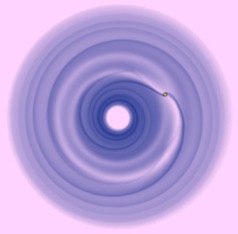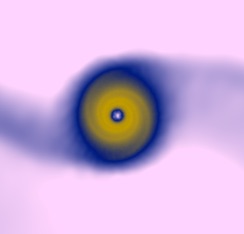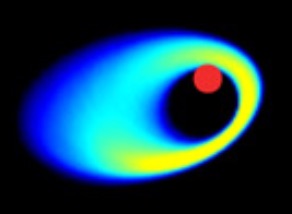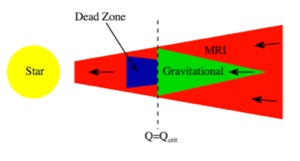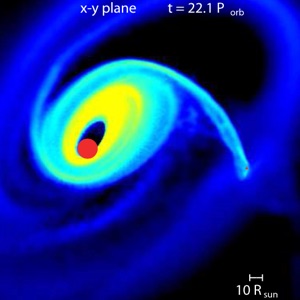Research

Accretion Theory
Accretion discs form when gas is transferred from one celestial object to another. The material has too much angular momentum to fall directly on to the object so instead orbits around and collides with itself. Viscosity, driven by the magneto-rotational instability (MRI, Balbus & Hawley 1991), spreads the accreting material out into a disc that carries angular momentum outwards allowing the mass to fall inwards. The matter orbits the central object at Keplerian velocity and gradually spirals in through the disc to be accreted on to the central object. Such discs are ubiquitous in the Universe and form on all scales from planetary to galactic sizes. They are a vital component of star and planetary system formation and power some of the most energetic objects in the universe, X-ray binaries and active galactic nuclei. Understanding angular momentum transport in accretion discs is fundamental to explaining the formation of systems on all scales from satellite systems, to planetary systems and the growth of supermassive black holes. This makes this area uniquely promising for a theorist, as progress in disc theory has very wide applications to a range of astronomical problems.
Protoplanetary Discs
Protoplanetary discs are circumstellar discs around newly formed stars. The ionisation fraction at the mid-plane of such discs is thought to be low enough that the gas is not well coupled to the magnetic field and a dead zone forms where the MRI cannot drive angular momentum transport (Gammie 1996). During the early evolution of these discs, while the infall accretion rate is high, the discs may become unstable to the gravo-magneto disc instability (Martin & Lubow 2011, 2013a,b). The turbulence transitions between gravitationally produced to magnetically produced and the result is large accretion outbursts on to the central star. This disc instability is thought to explain FU Orionis outbursts.
It is within the protoplanetary disc that planets form in the later evolutionary stages. The quiescent dead zone region is a likely formation site because dust settles to the mid plane there. The 3D SPH simulation shown above shows a circumstellar disc with a Jupiter mass planet. The left shows the whole disc and on the right, zoomed in on the planet with its circumplanetary disc. Circumplanetary discs are also likely to have dead zones and we found that during the early evolution with accretion rate typical in the T Tauri phase they are also unstable to the gravo-magneto disc instability (Lubow & Martin 2012).
Planet Formation in Binaries
About half of observed exoplanets are estimated to be in binary systems. Thus, understanding planet formation and evolution in binaries is essential for explaining observed exoplanet properties. Observations of discs in binary star systems suggest that they can be highly misaligned to the binary orbital plane (e.g. Jensen & Akeson 2014). Recently we found that a highly misaligned disc around one component of a binary star system will be unstable to KL oscillations (Martin et al. 2014). The disc undergoes global inclination and eccentricity oscillations.
Be/X-ray Binaries
Be/X-ray binaries consist of a Be star and most frequently a neutron star binary. Be stars are rotating rapidly, at around 70% of their break up velocity, and have viscous decretion discs (e.g. Porter 2003). They are observed to have two types of X-ray outburst. Type I outbursts occur each orbital period of the binary. Because the orbit is typically eccentric, they are occur when the orbit is at periastron. The type II X-ray outbursts are more difficult to understand. They occur much less frequently but have a much brighter luminosity and last for several orbital periods with no orbital modulation. We explained these outbursts as the result of KL oscillations of the Be star disc. The disc is highly misaligned since the supernova explosion that formed the neutron star. The type II outburst occurs when the Be star disc becomes very eccentric and drives significant mass transfer on to the neutron star. See my separate page for further details.
For more information see:
gravo-magneto disc instability
